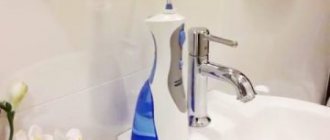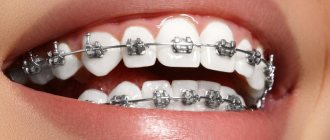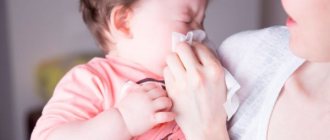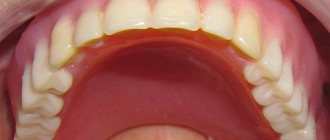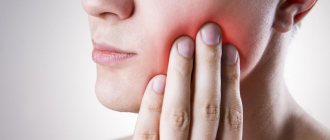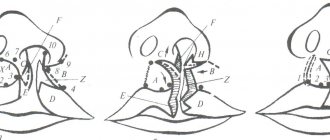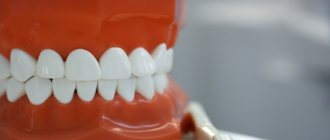500
Cleft palate is considered one of the most serious malformations of the jaw and face. According to WHO, its incidence is 0.6-1.6 cases per 1000 newborns.
The result of this pathology is a violation of sucking, swallowing (food passes from the mouth to the nasal cavity), breathing (due to distortion of the nasal passages), speech (becomes nasal).
Treatment for cleft palate consists of closing the pathological communication between the oral and nasal cavities. This is done surgically or, if something prevents the operation, by installing a prosthesis called an obturator (Latin Obturare means to close, seal).
A little bit of history
Today, obturators are usually a temporary measure taken when surgery cannot be performed immediately. However, there were times when they were the only solution to a problem.
It is believed that the first obturator was developed in 1561 by the Frenchman A. Paré. Its design resembled a cufflink, covering a cleft in such a way that one part of it was located in the oral cavity, and the second in the nasal cavity. The device was collapsible.
In 1964, Pare improved his design by replacing the nose with a sponge. The device was installed through the oral cavity, the sponge was pushed through the crevice, swelled while in the nasal cavity, and protected the structure from falling out.
Pierre Fauchard modified the Pare device by installing movable ivory wings instead of a sponge. When installing the structure, the wings were given a vertical position and inserted into the defect from the oral cavity.
Then, using a screw, they were straightened horizontally, so that they did not allow the device to fall out of the crevice. Due to the hard ivory in the nasal cavity, bedsores and tissue atrophy occurred, so the design was considered unsuccessful.
A fundamentally new solution was proposed in 1820 by Delyabar. His obturator included two parts - a metal plate with clasps that fit over the teeth, and a rubber part that closed the cleft. The parts were connected to each other by hinges.
Kingsley in 1864 developed a design in which a movable velum was connected to a fixing part using a spring.
The main problem with obturators is that the soft tissues of the palate, and, consequently, the cleft, move (“play”) during the process of chewing, swallowing and speaking. The fixing part remains motionless at this time.
The optimal way to connect the moving part with the fixed part was the main object of improvement. Work was also carried out on the configuration and material of the part covering the crevice.
Let's consider the laboratory stages of manufacturing the Johnson apparatus and its functional features.
Come here to find out how effective the Korkhaus apparatus is for the treatment of diastemas.
At this address https://orto-info.ru/sistemyi-vyiravnivaniya-zubov/individualno-izgotovlennyie-apparatyi/begga.html we will consider the design of the Begg apparatus.
What functions do obturators perform for palate defects?
164
Obturators are prosthetic structures or devices designed to close or “clog” pathological defects in the walls of the oral cavity.
Most often, obturators are used to eliminate defects in which a violation of the communication between the oral cavity and the nose is diagnosed.
Doctors resort to fixing such products only if it is impossible to eliminate the defect with plastic surgery, or when the patient refuses surgical treatment.
Designs used
The ability to manufacture more effective and convenient obturators appeared only in the 19th century. Devices that fully correspond to the shape of the palate and the edges of the defect began to be created from rubber, rubber and gutta-percha.
The following options have been proposed for the soft palate:
- Kingsley apparatus with movable connection of parts (1864).
- Schiltsky obturator with a long plate, a rear spring and an obturating part made of soft rubber (1885).
- Inelastic construction of Suersen, used in the absence of muscles of the soft palate or in case of their atrophy (1867).
- Khrushchev's obturators - hard and with a pneumatic soft balloon (1884).
- Case's claspless "floating" apparatus (1902).
The pioneer of maxillofacial orthopedics, as an independent branch in dentistry, was K. Marten after describing a new design that replaced a jaw defect and opened up unique opportunities for successful prosthetics.
At the moment, dentistry has in its arsenal a large number of varieties of obturators. The components of any of the models are made according to the obtained palatal impression.
Reasons for installation
The optimal period for surgical treatment of nonunions today is considered to be 8-13 years - the time of variable and the beginning of permanent dentition. Until this period, treatment with obturators can be used as a temporary measure.
Indications for it are the following cases:
- Various types of congenital nonunion of the palate - partial, complete, combined, etc.
- Acquired pathologies - injuries, wounds, destructive phenomena in the upper jaw, consequences of operations.
- Problems with speech and sucking in children due to the presence of communication between the nose and mouth.
Obturators may also be indicated for combined pathologies, in which nonunion of the palate is combined with other congenital or acquired defects.
These include a deviated nasal septum, oblique facial cleft, closure of the internal nostrils, etc.
Fastening methods
All obturators, with the exception of floating ones, consist of 2 parts - fixing and obturating. The first serves as a base, which is attached to the supporting teeth using clasps or, in case of toothless jaws, vacuum.
The obturating part directly covers the cleft and is attached in one way or another to the base. Depending on the method of their connection, they are distinguished:
- movable obturators (the obturating and fixing parts are movably connected);
- fixed (rigid, monolithic), in which the overlapping and fixing elements are rigidly connected to each other.
The 3rd type of obturators includes floating structures. They do not have a fixing part, and are attached directly to the cleft, tightly covering its edges and “floating” with it.
These types include devices by Kez, Chasovskaya, etc.
Obturators with a movable connection, in turn, are divided into 2 types:
- semi-movable (designs by Shildsky, Pomerantseva-Urbanskaya);
- mobile (Ilina-Markosyan device).
Special types of obturators include designs used for feeding infants with cleft palate.
Thus, there are 5 types of structures that cover palatal clefts - rigid (monolithic), movable, semi-movable, floating and devices for feeding children.
Fixation methods
The design features of obturators differ depending on the location, shape and size of the pathological area. Plastic is now more often used for manufacturing. The material is durable, ductile and safe. All these properties allow you to wear the device comfortably.
The structures are made according to the same principle as removable dentures. A specialist, using elastic or functional impression material, takes an impression of the jaw defect, which later becomes the basis for modeling an obturator of the desired shape and size.
There are 3 ways to attach devices:
- coverage of the edges of the cleft (floating);
- connection to base or button (movable);
- association with plate (fixed).
Fixation of the palatal plate to the dental units of the upper jaw is carried out using clasps. The plate is placed in the oral cavity so that its surface covers the palate defect.
In this case, a border should be formed between the oral and nasal cavities. With complete edentia, such a device becomes a prosthetic structure on which artificial teeth are placed.
Popular models
Most obturators in use today (at least their conceptual, basic design) were developed in the early to mid-20th century, or even earlier.
In particular, Suersen’s apparatus was proposed in 1867, Schildsky’s in 1885, Kez’s in 1902, and Kurlyandsky’s in 1957.
At this time, the developers did not have the modern polymer materials that appeared later at their disposal. When they appeared, the basic designs were improved, adapting to new materials.
The technology for manufacturing obturators in general involves taking an impression of the upper jaw and cleft, casting a plaster model on it, and manufacturing a fixing part (usually in the form of a basic polymer plate with clasps).
Then, an obturating element is made using the fixing part installed on the jaw.
Below are some obturator models. Some of them have only historical significance, others continue to be used in our time.
According to Kurland
Kurlyandsky's design is a double-action device. Includes an expansion plate for the upper jaw with a screw and the obturator itself - an elastic hood located on the seam of the expansion plate.
Used when nonunion of the palate is combined with a narrowed upper jaw
The device is still in use today. In addition to this, there are other obturators that combine orthodontic devices or prostheses with elements that bridge the cleft palate.
Along Pomerantseva-Urbanskaya
The Pomerantseva-Urbanskaya obturator belongs to structures with a semi-movable type of connection of their parts.
It is used mainly for the treatment of pathologies of the soft palate that are of syphilitic origin, when the soft tissues are completely immobile. Particularly effective for speech restoration.
The obturator consists of a palatal plate with clasps (fixing part) and an overlapping part connected to it. The connection is made with a flexible steel plate about 0.5 mm thick and 6-8 mm wide.
The element covering the crevice has 2 holes, closed on different sides with celluloid plates. The latter act as valves.
One opens under the influence of air movement towards the nasal cavity (when exhaling), the other - towards the oral cavity (when inhaling).
Stages of manufacturing elements of removable orthodontic appliances and their types.
In this publication we will look at the purpose of the Janson bionator and the features of its design.
Here https://orto-info.ru/sistemyi-vyiravnivaniya-zubov/individualno-izgotovlennyie-apparatyi/korrektsii-distalnoy-okklyuzii-persina.html all about using the Persin apparatus for distal occlusion.
Palatal plate
The protective palatal plate is a monolithic structure used to close limited nonunions of the palate and protect the surgical suture and stabilize tampons and flaps after surgery.
The structure is attached to the supporting teeth using clasps. The device is effective for speech restoration. Palatal plates of Frigof, Urbanskoy-Frigof and others are used.
According to Ilina-Markosyan
Ilyina and Markosyan developed two obturators. The first model turned out to be insufficiently effective, the second is used in our time. It consists of 2 parts - a movable obturator and a palatal fixation.
The latter is made in the form of a plate of hard plastic, and is fixed on the supporting teeth with clasps.
The obturating part is made of elastic plastic and looks like a thin plate. Located on the side of the nasal cavity , it is connected to the palatal plate with a metal button, the axis of which passes through the cleft.
The design of the button ensures the necessary mobility of the overlapping part relative to the palatal plate.
Floating Kez model
Floating palate obturators, which include the Kez model, do not have a fixing base. The structure is attached directly to the cleft thanks to a contour with a groove that covers the edges of the defect.
Floating obturators are considered the most physiological among others. In addition to lightness and small size, their advantages include a special position in relation to the pharyngeal and palatine muscles, which contributes to their development.
In earlier times, the use of the Kees model was limited by the difficulty of taking an accurate impression of the defect. Today, thermoplastic elastic polymers are available that simplify this task.
According to Schildsky
The fixing part of the Shildsky obturator is a base plate or denture, from the rear end of which comes a spring connected to the obturating part.
The latter was previously made from vulcanized rubber, which over time became unhygienic due to the formation of cracks in which food debris accumulated and decomposed. Subsequently, rubber was replaced by plastic, which has good hygienic properties.
According to Suersen
The C Yuersen obturator was developed a long time ago, but is still considered one of the best for speech restoration. Refers to fixed (monolithic) structures.
The overlapping part is fixedly connected to the fixing plate. Previously, it was made from black gutta-percha, but today other materials are used.
Reviews
Obturators are used exclusively according to indications in cases where it is impossible to eliminate the defect with plastic surgery or when the patient does not want to allow surgical interventions in his body.
Have you ever had to wear an obturator? If yes, leave your feedback on the effectiveness of the device in the comments below.
If you find an error, please select a piece of text and press Ctrl+Enter.
Tags removable dentures
Did you like the article? stay tuned
Previous article
Details about professional teeth cleaning with the Prophyflex handpiece
Next article
Bioblock is a unique system in orthodontics for expanding the upper jaw
